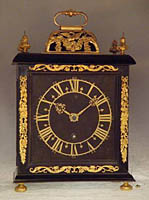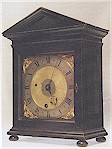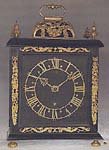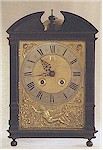|
Museum of the Dutch Clock
Contents: INTRODUCTION Special exhibition about the exchange between Dutch and English
clockmakers after the introduction of the pendulum clock by Christiaan
Huygens. After Huygens en the London-based clockmakers family Fromanteel
in 1658 introduced the clock with pendulum escapement to London, several
English clockmakers like John and Ahasuerus II Fromanteel and Joseph
Norris established workshops in Amsterdam. The exhibitions shows beautiful
examples by these famous makers. In his turn Joseph Norris made Holland
familiar with the longcase clock. The characteristic Hague Clock gave way
to table clocks according to the English model. Also Dutch makers like
Pieter Klock and Bernard van der Cloesen manufactured table clocks in the
English way, apart from unmistakably still Hague features. Thus a curious
table clock within the exhibition shows a striking mix between Hague
tradition and English fashion awareness. The skeleton chaptering on a
velvet covered dial is boxed in a clock case with brass basket and
appliqués in William&Mary style. The style époque of King George I is
illustrated by table clocks by Jacob van der Cloese, Roger Dunster and
Allin Wallker. The exhibition is composed out of several private loans,
joined by masterpieces from the National Museum from Musical Clock to
Street Organ in Utrecht and the Dutch Gold, Silver and Clock Museum in
Schoonhoven.
A later
example is Hans Nilve (Nilou) working in England around 1609, who made a
musical clock for King James I. From this time on the lantern clock was
the most important type of domestic clock in England. In The Netherlands
the first domestic clocks characterised this period, originally
equipped with a balance wheel as regulator.
Already September 3, 1657, a contract was made between Coster and John Fromanteel from London to work as an apprentice of Coster. Shortly after his return to England, the Fromanteel firm advertised “clocks that go exact and keep equaller time then any now made without this Regulator”.
Dutch
table clock ‘Bern. van de Cloesen fecit Hagae’ 1690-1700 After the first clock cases with a simple design, the case of the Hague clock evaluated to a form derived from classic architecture. This classicistic design of the Hague clock influenced the design of the English clock cases, the so-called architectural style. |
In 1689 the Dutch Stadtholder William II became King of England by his marriage to Mary Stuart, daughter of the former English king. His court-architect Daniel Marot designed countless interiors and gardens in a sumptuous baroque style like that of Paleis Het Loo. This style is known as the William & Mary style. Marot also designed clock cases. These designs have been of great influence to the compositions of clocks by Thomas Tompion, court-clockmaker of William & Mary. The most renowned example is the first year clock, produced in silver, which was in use from 1689 on in the King’s bedroom (the so-called Mostyn Tompion, named after Lord Mostyn who sold the clock to the British Museum in 1998).
The end of the 17th and increasingly the 18th century is characterised by international exchange and a growing industrialisation of the production of clocks. Proofs of overseas export of clock components and cases have been documented. The English Henry Sully is a figure characteristic for this phenomenon, who after a stay in Leiden founded several clockmakers' workshops in France for which he hired tens of clockmakers from London. A rule by the clockmakers’ guild from The Hague in 1711, that clocks should be signed with the makers name and place of origin, can be considered to be a reaction to this internationalisation. The rise of forgeries later on in the 17th century can be considered to be a consequence of this.
Route by train: from Amsterdam station to Koog-Zaandijk (15 min.) from there a ca 8 min. walk. The Museum of the Dutch Clock has a unique collection of exclusively Dutch mechanical clocks. The Museum illustrates the evolution of Dutch clockmaking between 1500 and 1850 by representative examples from the different periods.
|



